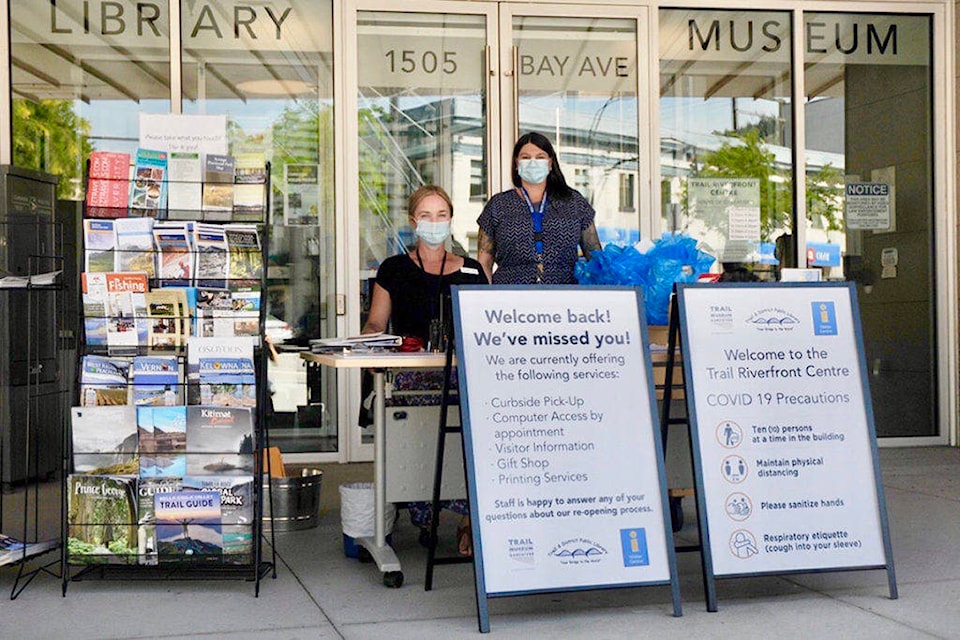Visitor statistics in the City of Trail have taken a nosedive this year, which is no surprise given the coronavirus pandemic shut everything down cold in March.
When civic services resumed three months later, it was at a marginal degree compared to historical hours of operation.
With the Columbia Basin Rural Development Institute (RDI) releasing a detailed report this week targeting COVID impacts on local tourism, showing this region - the Kootenay Rockies - neared a 50 per cent drop this summer, the Trail Times contacted the municipal visitor centre to see what the picture looks like in the city.
“We saw a drop in tourists by about 40 per cent compared to last year, but we certainly expected a larger reduction,” explained Sarah Benson-Lord, manager of the museum and archives in the Trail Riverfront Centre.
“Without any large family gatherings, tournaments, class reunions, major events, etc., we missed engaging with the larger groups of people who are always so keen to visit our building. Also reflected in that number is the border and airport closure.”
Last year, American and European travelers to the area accounted for about 10 per cent of the city’s tourists.
“Many of the people we welcomed were camping in the area and were looking for both local information and neighbouring information,” Benson-Lord said.
“We kept a good watch on what food services and accommodators were open in Trail in order to make solid recommendations to our visitors.”
The visitors centre is housed in the Riverfront Centre, which is also home to the integrated museum and public library.
When the library reopened on June 15 with curbside pick-up and exterior visitor services, staff noted steady numbers.
The building was opened to patrons on July 6, with three people permitted inside at a time, which allowed for bookable computer services.
Toward the end of July, city staff opened the galleries and stacks, and bumped up the maximum of indoor visitors to 10.
“This is where we are now and it is working well for us,” Benson-Lord said. “Some in-person programming has begun, with very limited numbers and strict protocols, and it’s been great getting back into the swing of things. “
To put reduced hours operations into perspective, Benson-Lord provided the following visitor statistics from mid-June to the end of September.
Front door guests: 8,023 - compared to 28,222 for the same time last year
Museum guests: 584 - compared to 2,655 for the same time last year
Visitor centre guests: 1,120 - compared to 1,609 for the same time last year
“It’s important to note we don’t track every person who enters the Riverfront Centre as a ‘tick’ for all three services and some people just enter to use the washroom, but it will still be counted in our front door count,” Benson-Lord pointed out.
“We do our best to interact with our patrons to understand their purpose for coming, and the museum tally is for the second floor gallery only,” she added.
“Also, please keep in mind the library summer programming is so well-attended (historically) and we didn’t experience any of that this year, unfortunately.”
The COVID-19 pandemic had an immediate impact on tourism activity in the region due to the dramatic reduction in international travel, including the Canada/US border being closed to non-essential traffic, the RDI reports.
“Tourism plays an important role in the local economy and social dynamics of a community, so the reduction of tourists due to the pandemic has been felt throughout the region.”
According to Destination BC visitor statistics, April through June 2020 saw a 79 per cent drop in total visitors to visitor’s centers in the Kootenay Rockies Tourism Region compared to the same time period in 2019.
In June, the B.C. government moved into Phase 3 of its Restart Plan, which provided guidelines and advice for safe travel within the province. Tourism activity did increase over the summer, but still much less than experienced in 2019.
There were 116,196 total visitors to visitor centers between July and September 2020.
This is 48 per cent fewer visitors than was seen over the same time period in 2019.
Traffic stations also show the impact the pandemic had on the volume of vehicles, including for tourism, moving throughout the region. Highway 3 west of Castlegar saw a 29 per cent decrease in vehicle traffic in May 2020 compared to May 2019.
The Crowsnest Pass and Rogers Pass experienced a similar decrease (28 per cent and 26 per cent, respectively).
The institutes reports that a survey conducted this summer on resident sentiment on tourism in the Kootenay Rockies Tourism Region, most respondents were comfortable welcoming visitors from within the region and rural B.C. in general.
The majority of respondents indicated they were comfortable or somewhat comfortable travelling within B.C. during the summer.
With most summer travel limited to within the province, BC Parks played an important role in supporting the tourism industry.
Although updated statistics on park visitation are not yet available, anecdotal information points to an increase in overnight camp stays.
